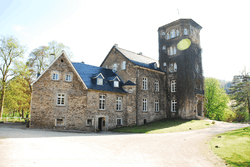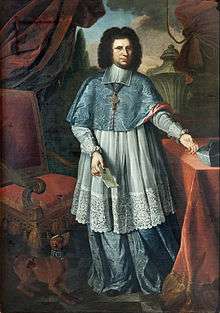House of Plettenberg

The House of Plettenberg is a Westphalian noble family of the Uradel. It dates back at least to 1187, when Heidolphus de Plettenbrath was mentioned in a document by Philip I (Archbishop of Cologne).[1]
Origins
The family's first estate was located at Plettenberg. Hunold I. was Marshal of the Duchy of Westphalia which was ruled by the Archbishop of Cologne. His son Heydenricus de Plettenberg was cited as bailiff of the Counts of Arnsberg in 1258[2] and became himself marshal of Westphalia in 1266. His son John I. was marshal between 1294 and 1312. Heydenricus' brother Gerhard became Drost (Lord High Steward) of Engelbert III of the Mark. He fortified Schwarzenberg Castle at Plettenberg for the House of La Marck's feuds with the archbishops. In 1513 the castle passed into the ownership of the Plettenberg family which still owns the ruin today.
The two branches of the family still existant today are the Schwarzenberg branch (Count von Plettenberg-Heeren, Barons von Plettenberg and Barons von Bodelschwingh-Plettenberg) who are all Lutherans (Evangelical Church in Germany) and the Counts von Plettenberg-Lenhausen (Roman Catholics).[2]
Schwarzenberg Branch
The Schwarzenberg branch was elevated to the rank of Barons of the Holy Roman Empire in 1689. Since 1433 they lived on their estate at Bamenohl. In 1726 they acquired Hilbeck estate near Werl and in 1767 Heeren Castle near Kamen. In 1861 they also inherited Sandfort Castle near Olfen. All of these estates are still today owned and inhabited by the family. In 1913, Wilhelm II, German Emperor, elevated the respective owners of Heeren to the primogenital rank of counts while all other family members remain barons.
In 1788, Baron Karl Wilhelm Plettenberg married Anna Luisa von Bodelschwingh, heiress of Bodelschwingh Castle at Dortmund, and changed his name to Baron von Bodelschwingh-Plettenberg. His grandson Karl (1821-1907) was made Count in 1888, and passed his titel and estate to his only daughter Wilhelmine who married Baron Dodo Alexander zu Innhausen und Knyphausen (1835-1911). While their son Karl Moritz (1871-1958) and the grandson Edzard (b. 1905) still used the primogenital titel Count von Bodelschwingh-Plettenberg, the present generation is only using the name Baron zu Innhausen und Knyphausen. They still own Bodelschwingh House.
-

Bamenohl House
-

Hilbeck House
-
Heeren Castle
-

Sandfort Castle
-

Bodelschwingh House
Lenhausen Branch
Heidenreich von Plettenberg (ca 1450-1485), a second son of Bamenohl House, acquired the neighboring Lenhausen Castle near Finnentrop in 1457. In 1494 Stockum estate at Sundern was purchased. Friedrich Christian von Plettenberg (1644-1706) became Prince-Bishop of Münster in 1688. One year later, the Lenhausen-Stockum branch was elevated to the rank of Barons of the Holy Roman Empire, together with the Schwarzenberg branch, in 1689. In 1710 they acquired Hovestadt Castle at Lippetal. In 1724 the Lenhausen barons were made Imperial counts.[2] Prince-Bishop Friedrich Christian built the monumental Schloss Nordkirchen, and his nephew Ferdindand (1690-1737), prime minister of the Electorate of Cologne, inherited it and accomplished it by 1734; the Plettenberg family owned Nordkirchen until 1833. The castles at Lenhausen and Hovestadt are still today owned and inhabited by the counts von Plettenberg-Lenhausen.
-
.jpg)
Lenhausen Castle
-

Hovestadt Castle
Notable members

- Wolter von Plettenberg (around 1450–1535), Master of the Livonian Order
- Gertrud von Plettenberg (15??–1608), royal mistress of Prince-Elector-Archbishop of Cologne Ernest of Bavaria
- Friedrich Christian von Plettenberg (1644–1706), Prince-Bishop of Münster
- Ferdinand von Plettenberg (1690–1737), Prime Minister of Archbishop-Elector Clemens August of Bavaria
- Joachim van Plettenberg (1739–1793), Governor of the Cape of Good Hope and founder of Plettenberg Bay
- Karl von Plettenberg (1852–1938), General of the Infantry, Commandant-General of the Guards Corps and Adjutant General of the German Kaiser
- Kurt von Plettenberg (1891–1945), plenipotentiary of the House of Hohenzollern (the royal house of Prussia), one of the inner circle of the July 20th plot against Hitler
- Georg von Plettenberg (1918-1980), Colonel of the Bundeswehr
References
- ↑ Deed of the Oelinghausen monastery (transcript, German)
- 1 2 3 Enache, Nicolas. La Descendance de Marie-Therese de Habsburg. ICC, Paris, 1996. pp. 88, 92, 150, 161. (French). ISBN 2-908003-04-X
.jpg)